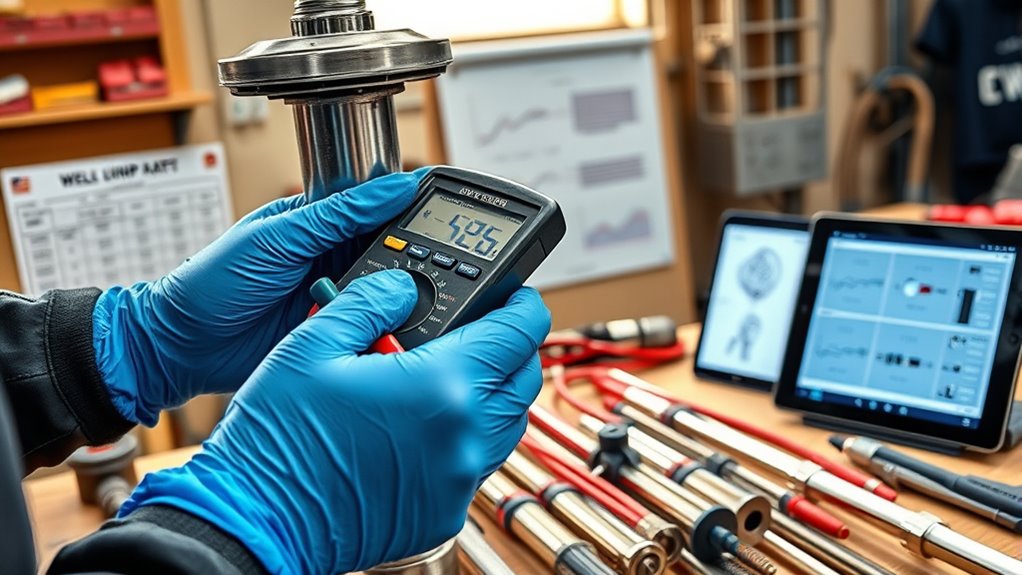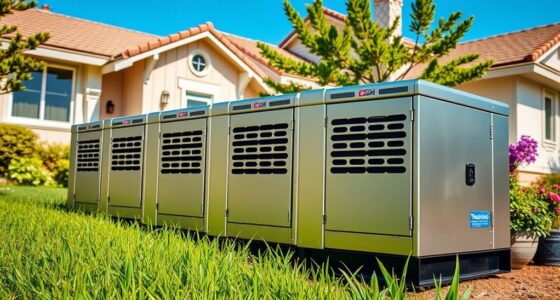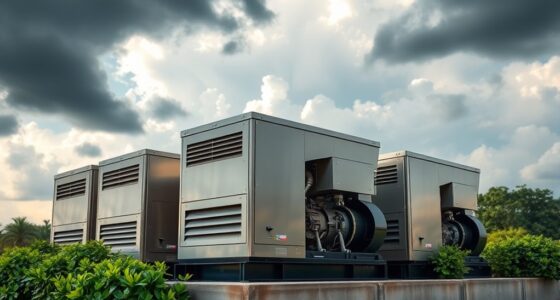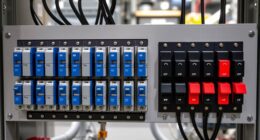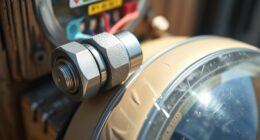To troubleshoot heat pump and well pump sizing issues, first check if your system meets your home’s heating or cooling demands and matches well flow rates. Look for signs like noisy operation, short cycling, or uneven temperatures, which indicate sizing problems. Use tools like flow meters and pressure gauges to verify correct capacity. If problems persist, consulting a professional ensures accurate assessment and long-term efficiency. Keep exploring for detailed tips and solutions you can implement today.
Key Takeaways
- Proper sizing ensures energy efficiency, reduces wear, and prevents system strain or frequent cycling.
- Measure home size, climate, and water demand accurately for optimal pump capacity calculations.
- Use tools like flow meters and pressure gauges to verify system performance and proper sizing.
- Signs of incorrect sizing include temperature fluctuations, high energy bills, noise, and short cycling.
- Consult a professional when troubleshooting persistent issues or performing complex load assessments.
Understanding the Basics of Heat Pump and Well Pump Sizing

Understanding the basics of heat pump and well pump sizing is essential to guarantee your systems operate efficiently and reliably. Proper sizing directly impacts energy efficiency, helping you save on energy bills and reduce wear on equipment. When selecting a pump, consider system compatibility—ensuring the pump’s capacity matches your household or property’s needs. An undersized pump may struggle to provide enough water or heat, leading to increased energy consumption and system strain. Conversely, an oversized pump can waste energy and cause unnecessary wear. Accurate sizing involves understanding your specific load requirements, water flow rates, and temperature demands. By focusing on these key factors, you ensure your heat and well pumps function at their best, delivering reliable performance with maximum energy efficiency. Additionally, reviewing the maintenance requirements of your pumps can help prevent costly repairs and extend their lifespan.
Why Proper Sizing Matters for Efficiency and Longevity
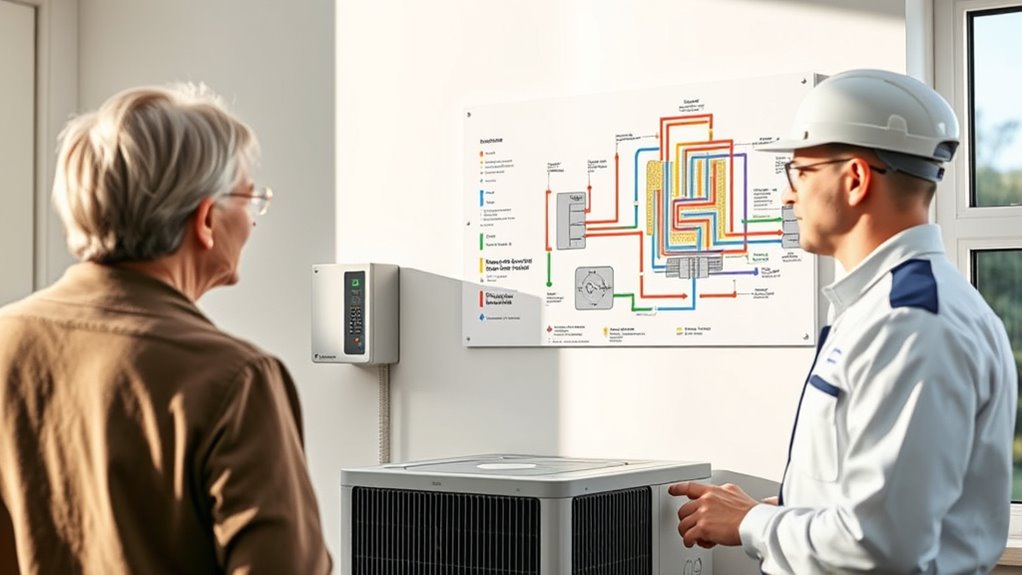
Choosing the right size for your heat pump or well pump directly affects how well the system performs over time. Proper sizing boosts energy efficiency by preventing the system from working harder than necessary, which reduces energy bills. An appropriately sized pump also minimizes wear and tear, helping extend the equipment’s lifespan. When your pump is too small, it struggles to meet demand, leading to overworking and increased fatigue on parts. Conversely, an oversized pump cycles on and off frequently, causing stress and rapid deterioration. Correct sizing ensures smooth operation, steady performance, and reliable output. Proper sizing also involves accurate assessment of your system’s capacity requirements, ensuring optimal operation under varying conditions. Ultimately, investing in the right size saves you money long-term by maintaining efficiency and prolonging the longevity of your equipment.
Common Signs of an Undersized or Oversized Pump

If your heat pump isn’t keeping your home comfortable or your well pump struggles to meet demand, it might be a sizing issue. You could also notice strange noises or vibrations that seem out of place. Recognizing these signs early can help prevent bigger problems down the line. Additionally, incorrect sizing can lead to inefficient operation and increased energy costs, underscoring the importance of proper pump sizing and calibration.
Insufficient Heating or Cooling
When your heat pump or well pump isn’t providing enough heating or cooling, it often signals that the system might be improperly sized. This can lead to inconsistent temperature fluctuations, making your space uncomfortable and reducing energy efficiency. An undersized pump struggles to meet demand, causing it to run constantly without enough output. Conversely, an oversized pump may cycle on and off frequently, wasting energy and creating uneven temperatures. To identify these issues, watch for:
- Persistent temperature fluctuations despite thermostat adjustments
- Increased energy bills without improved comfort
- Short cycling or inadequate heating/cooling periods
- Proper sizing is essential for optimal performance and energy savings.
Addressing sizing problems ensures your system runs efficiently, maintains consistent temperatures, and minimizes energy waste. Proper sizing is key to maximizing performance and comfort in your home.
Excessive Noise or Vibration
Excessive noise or vibration from your pump often signals a sizing problem, whether it’s undersized or oversized. Vibration causes can include imbalance, loose fittings, or improper installation. When a pump is too large, it may operate at high speeds, increasing noise and vibration. Conversely, an undersized pump struggles to meet demand, causing it to work harder and produce more noise. To reduce noise, ensure proper installation and alignment. Consider the table below to identify potential causes:
| Vibration Causes | Noise Reduction Tips |
|---|---|
| Pump imbalance | Tighten fittings and mounts |
| Improper installation | Regular maintenance |
| Excessive speed (oversized) | Use appropriate pump size |
Addressing these issues helps minimize vibration causes and enhances noise reduction. Additionally, understanding system compatibility can prevent many sizing issues before installation.
Calculating Your Heating and Cooling Needs
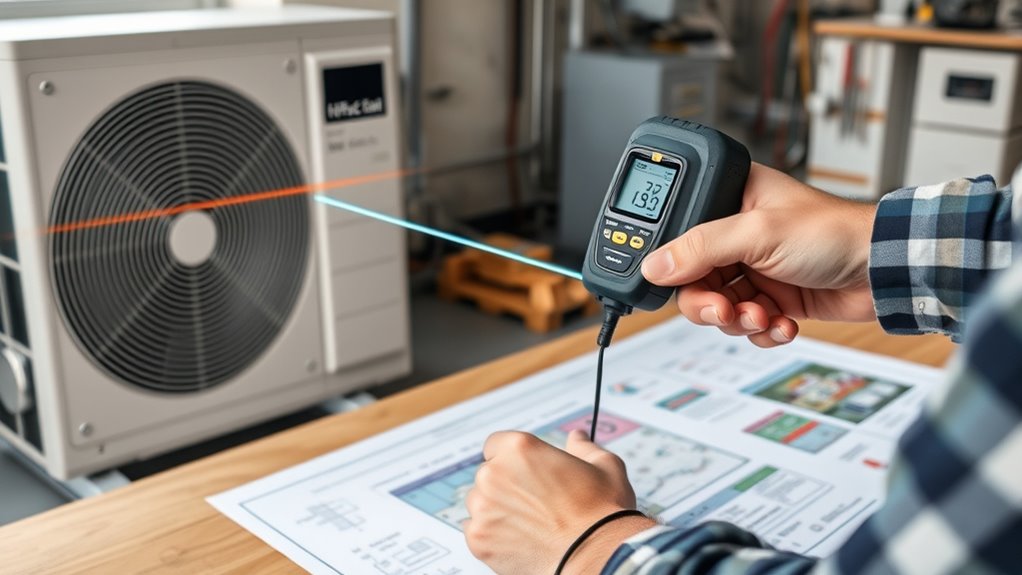
To accurately size your heat pump or well pump, start by figuring out your home’s square footage. You also need to take into account your local climate to understand how much heating or cooling is necessary. Together, these factors help ensure you choose equipment that keeps your home comfortable efficiently. For example, understanding the specific climate conditions can influence the size and performance features of Honda Tuning components suited for your vehicle.
Determine Home Square Footage
Determining your home’s square footage is a crucial first step in calculating your heating and cooling needs. Accurate measurements help guarantee your system is appropriately sized, optimizing energy efficiency and maximizing cost savings. To get precise figures, consider:
- Measuring each room’s length and width, then multiplying for total area
- Including all heated or cooled spaces, such as basements, attics, and garages
- Using existing blueprints or floor plans for reference if available
- Ensuring that headphones are not used during measurements to avoid distractions and improve accuracy.
Keep in mind that larger homes typically require more powerful systems, but efficiency depends on correct sizing. Overestimating can lead to unnecessary energy use, while underestimating may cause comfort issues. Accurate square footage helps you select the right size unit, ensuring energy-efficient operation and significant cost savings over time.
Assess Climate Conditions
Understanding your local climate is essential for accurately calculating your heating and cooling needs. Climate considerations, such as average temperatures, humidity levels, and seasonal variations, directly impact the size of your heat pump or well pump. Regional differences mean that what works in one area may not suit another, so it’s important to tailor your calculations accordingly. For example, colder regions require more heating capacity, while warmer, humid areas demand efficient cooling solutions. By evaluating these climate factors, you ensure your system is properly sized, avoiding inefficiency or insufficient performance. Additionally, considering noise levels of modern heat pumps helps ensure your system operates quietly and comfortably in your environment. Taking local climate considerations into account helps you select equipment that effectively handles your specific environmental conditions, ultimately saving energy and reducing long-term costs.
Factors That Influence Well Pump Capacity
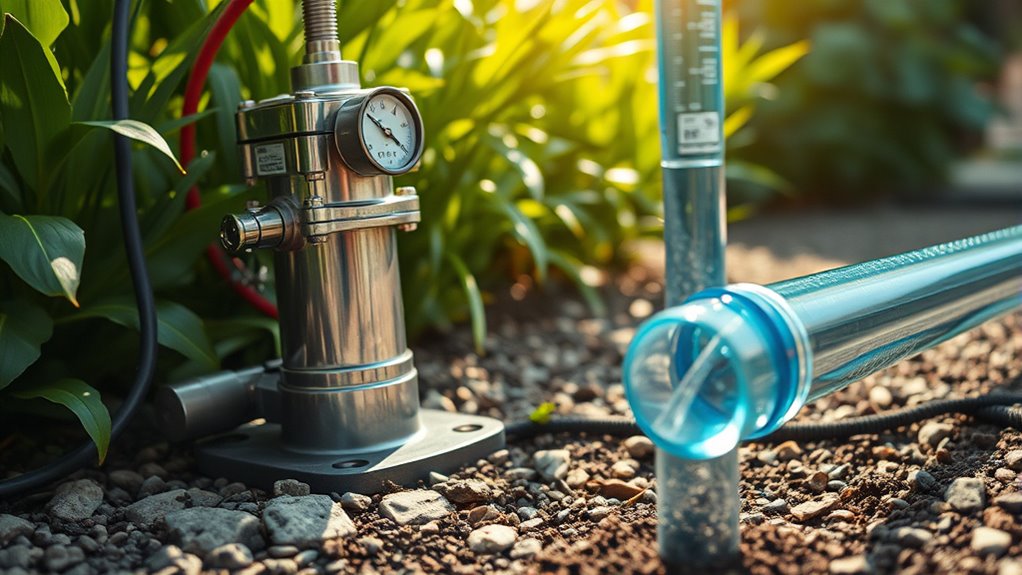
Several key factors directly impact well pump capacity, affecting how effectively it supplies water to your home or property. These factors influence well capacity and pump efficiency, ultimately determining if your system meets your needs. Proper seed incorporation techniques can optimize your system’s performance by ensuring consistent flow and preventing clogs or blockages.
- Well depth and yield: Deeper wells or ones with lower yields reduce well capacity, requiring a more powerful pump.
- Pump specifications: The pump’s design and size directly affect its ability to move water efficiently.
- Water demand variations: Fluctuations in your household water use can impact the required pump capacity to maintain steady flow.
Understanding these factors helps you select the right pump size and guarantees ideal performance, preventing issues like insufficient flow or premature equipment failure. Accurate consideration of these elements keeps your well system running smoothly and efficiently.
Tools and Methods for Accurate System Sizing

Accurate system sizing relies on a combination of specialized tools and practical methods to guarantee your heat pump or well pump operates efficiently. During pump installation, using precise measurement tools ensures the system is correctly matched to your home’s needs. Equipment calibration is essential to fine-tune performance, verifying flow rates and pressure levels. Tools like flow meters, pressure gauges, and load calculators help you determine the right size and capacity. Properly calibrated equipment minimizes guesswork, ensuring the system runs effectively and conserves energy. These methods not only improve efficiency but also extend equipment lifespan. Understanding Gold IRA options can inform investment decisions related to home upgrades or financial planning for maintenance costs. By focusing on accurate measurements and calibration techniques, you set a solid foundation for reliable operation and avoid costly sizing mistakes.
Troubleshooting Sizing-Related Problems Effectively
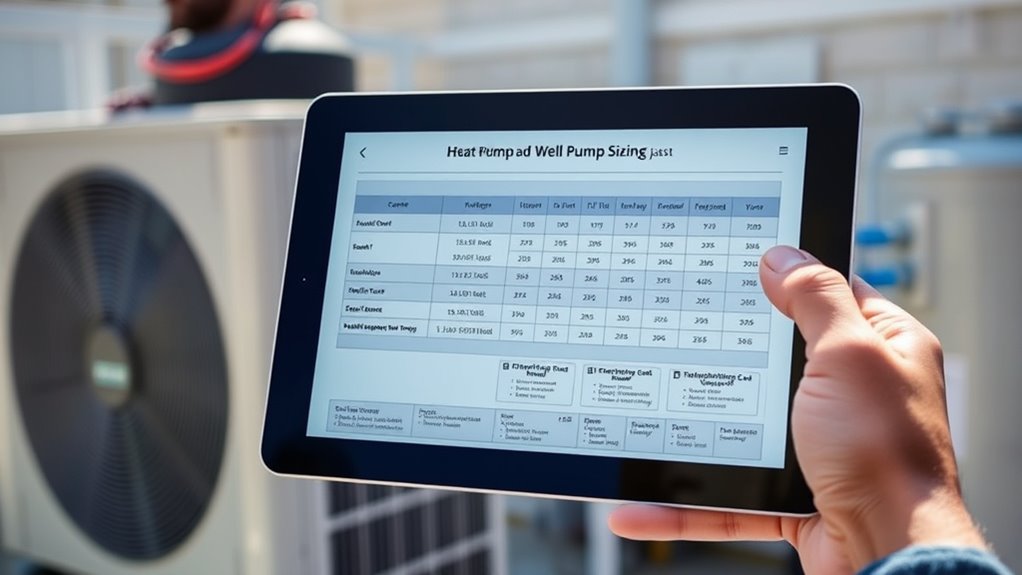
When a heat pump or well pump isn’t performing as expected, sizing issues are often the culprit. To troubleshoot effectively, start by evaluating the system’s capacity against your household’s needs and the well’s flow rate. Poor water quality can reduce efficiency and cause strain, so test for sediment, minerals, and contaminants. Additionally, check if the system is cycling on and off frequently, which signals improper sizing.
Proper pump sizing ensures optimal performance and prevents frequent cycling or strain.
Key points to consider include:
- Ensuring the pump’s size matches the demand for water volume and pressure
- Appraising water quality impacts on energy efficiency and system longevity
- Verifying that the system’s specifications align with the original sizing calculations
Addressing these factors helps resolve sizing-related issues, optimizing performance and extending your system’s lifespan.
When to Consult a Professional for Sizing and Repairs
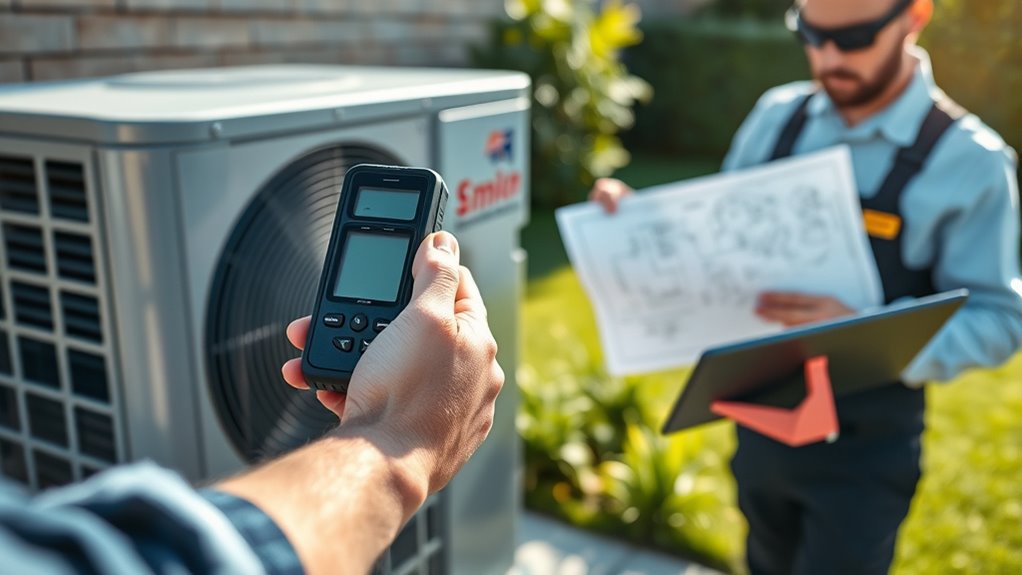
If sizing issues persist despite troubleshooting, it’s time to bring in a professional. While DIY fixes can sometimes resolve minor problems, complex sizing errors or frequent repairs indicate you need expert help. A professional can perform accurate load calculations and assess your system’s performance, preventing costly mistakes. Don’t risk further damage by attempting to adjust or repair beyond your skill level, especially if budget considerations are a concern. Investing in professional sizing and repairs can save you money in the long run by ensuring your heat pump or well pump operates efficiently and reliably. If you’re unsure whether your system is properly sized or if repairs seem beyond your capabilities, consulting a licensed technician is the best move to avoid ongoing issues.
Tips for Maintaining Optimal Pump Performance

Maintaining ideal pump performance requires regular attention and proactive measures. Establishing consistent maintenance routines helps prevent issues before they escalate, ensuring your system runs efficiently. Regularly inspect and clean filters, check for leaks, and monitor pressure levels. Implement energy saving tips like reducing unnecessary run times and optimizing system settings to lower energy consumption. Staying on top of these tasks enhances pump longevity and saves you money.
- Schedule routine inspections and cleanings to prevent buildup and blockages.
- Monitor pressure gauges regularly to catch deviations early.
- Keep an eye on system settings and adjust for optimal efficiency.
Frequently Asked Questions
How Often Should I Re-Evaluate My Pump Size?
You should re-evaluate your pump size whenever your household’s needs change, such as adding members or new appliances, or if you notice decreased pump efficiency. Follow proper sizing guidelines to guarantee peak performance. Regularly reviewing your pump’s performance helps maintain efficiency and prevents issues. Typically, it’s wise to reassess your pump size every few years or after significant home modifications to keep everything running smoothly.
Can Improper Sizing Cause Energy Bills to Spike?
Yes, improper sizing can cause your energy bills to spike. When your pump or heat pump is too large or small, it works inefficiently, reducing your energy efficiency. Overworking equipment can also shorten its lifespan, leading to more frequent repairs or replacements. Ensuring your pump is properly sized helps maintain peak performance, saves you money on energy costs, and extends the equipment’s longevity. Proper sizing is key to efficient, cost-effective operation.
Are There Specific Brands Better for Precise Sizing?
Yes, some brands are better for precise sizing due to their reputation for accuracy and quality. You should look for manufacturers known for consistent sizing accuracy, as this helps guarantee your heat pump or well pump performs efficiently without over- or under-sizing. Brands with strong reputations often invest in better technology and quality control, making them more reliable choices for achieving ideal sizing and energy efficiency in your system.
How Does Climate Impact Heat Pump and Well Pump Sizing?
Climate zones act like a tailor’s ruler, shaping your heat pump and well pump sizes. You’ll need larger units in colder regions with extreme temperature fluctuations to keep your home cozy. In milder climates, smaller equipment suffices. Understanding these climate nuances helps you avoid over- or under-sizing, ensuring your system runs efficiently year-round. Always consider your local climate zone and temperature swings when sizing your pumps.
What Are the Risks of DIY Sizing Mistakes?
DIY sizing mistakes can seriously impact your system’s performance. If you choose a pump with too much or too little pump capacity, it can lead to inefficient operation, higher energy costs, and potential equipment failure. Inaccurate sizing compromises system reliability and lifespan. Ensuring proper sizing accuracy is essential to avoid these risks, so it’s best to consult professionals who can correctly determine the right pump size for your needs.
Conclusion
Properly sizing your heat and well pumps might seem complex, but it’s essential for efficiency and durability. Don’t let worries about calculations hold you back—using the right tools and expert advice makes it straightforward. Remember, investing time in correct sizing now prevents costly repairs later. Trust the process, and you’ll enjoy reliable, long-lasting performance. Keep learning and stay proactive—your system’s health depends on it.
